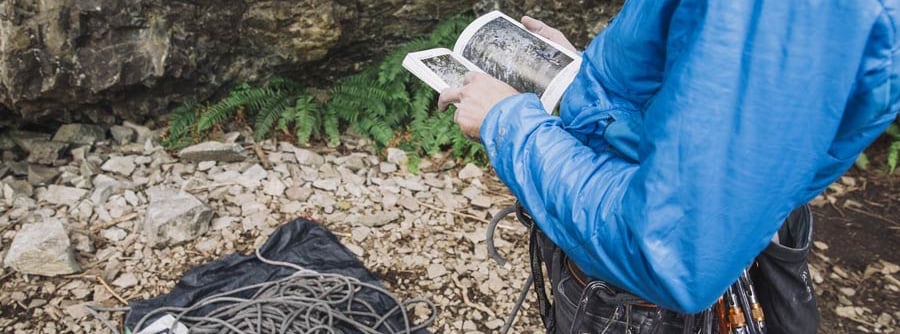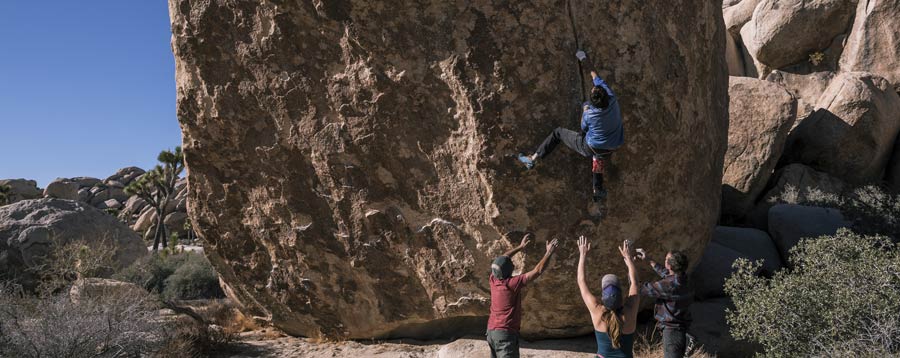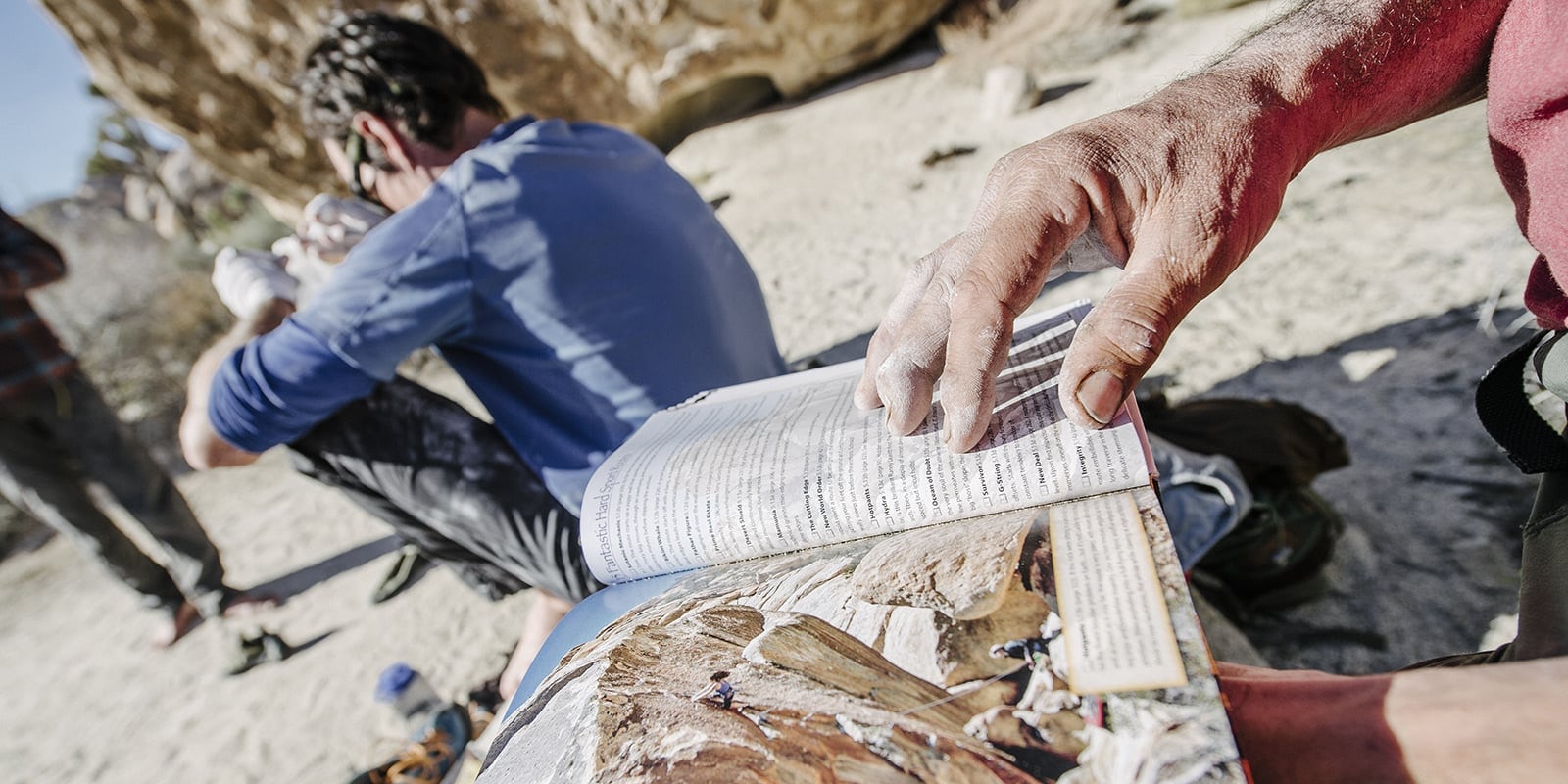Even if you've yet to find yourself on a sheer rock face, you've probably heard someone talk about doing a "5-point-something" climb when describing a route they've attempted or mastered. What they're describing is the difficulty level of the climb and the rating is from the Yosemite Decimal System (YDS). Though it was born in the outdoors, the system is also used to rate route difficulty in climbing gyms.
Much like the difference between U.S. and metric measuring systems, other countries' climbing systems are distinct: Germany, England, France and Australia all have their own ratings. This article will focus on U.S. ratings and will also explain the V Scale, its counterpart in the U.S. bouldering world.
Climbing Ratings Overview

Initially developed to describe a full range of backcountry travel, the YDS rates technical rock climbs from 5.0 through 5.15.
Route Classifications | ||
Class 1 |
| Walking an established flat, easy trail. |
Class 2 |
| Hiking a steep incline, scrambling, maybe using your hands. |
Class 3 |
| Climbing a steep hillside, moderate exposure, a rope may be carried but not used, and hands are used in climbing. A short fall could be possible. |
Class 4 |
| It is steeper yet, exposed and most people use a rope due to the potential of long falls. |
Class 5 |
| Climbing is technical and belayed roping with protection is required. It is not for a novice. Any fall from a Class 5 could be fatal. |
| Class 5 sub-categories | ||
5.1-5.4 | Easy | A steep section that has large handholds and footholds. Suitable for beginners. |
5.5-5.8 | Intermediate | Small footholds and handholds. Low-angle to vertical terrain. Beginner to intermediate rock climbing skills required. |
5.9-5.10 | Hard | Technical and/or vertical, and may have overhangs. These hard climbs require specific climbing skills that most weekend climbers can attain. |
5.11-5.12 | Hard to Difficult | Technical and vertical, and may have overhangs with small holds. Dedicated climbers may reach this level with lots of practice. |
5.13-5.15 | Very Difficult | Strenuous climbing that's technical and vertical, and may have overhangs with small holds. These routes are for expert climbers who train regularly and have lots of natural ability. |
6.0 | Can't be free climbed | Devoid of hand- and footholds, the route can only be aid-climbed. An added rating of A1 through A5 further designates difficulty level. |
The Evolution of Class 5 Ratings

Initially, the decimal-system basis for the YDS capped ratings at 5.9 for the most difficult climbs at that time. As climbers' skills and gear evolved, though, the need arose for higher ratings. Because 6.0 was already designated for aid climbing, ratings of 5.10 and above were added.
To further define a route's difficulty, a sub classification system of letters (a, b, c or d) is used for climbs 5.10 and higher. Thus a route rated 5.10a is easier than one rated 5.10d.
How to Use Climbing Ratings
The "crux," or hardest part of the climb, is the basis for the rating. Some guidebooks provide further clues to difficulty by adding a + or - rating:
- + indicates that a route sustains its level of difficulty most of the way
- - indicates that just one or two spots will be as difficult as the crux
Even though the numeric system is standardized, ratings can and do vary. A little context can help you get the most from climbing ratings:
- Ratings are environmental: When you move from the gym to the crag, start at a lower rating because weather and weathered hand- and footholds make things more challenging.
- Ratings are regional: Ratings may be relative based on their difficulty compared to other climbs nearby. When you're in a new area or gym, ask the locals if the ratings tend to be high or low there.
- Ratings can be personal: Ratings may be based on the climbing style or body type of the climber who developed the route.
- Ratings are informational: Ratings are guidelines, not Gospel. Don't obsess about a number. Use ratings to pick routes that are inspiring, challenging and fit the level of climbing you prefer.
- Ratings are situational: Pay more attention to the climbers at the crag than the posers at the pub.
Climbing Grades
Once you know how technically difficult a climb is, the next question is, "how long will it take?" Climbing grades provide guidance, suggesting the length of time an experienced climber might take to complete the route:
- Grade I: A couple of hours
- Grade II: Closer to four hours
- Grade III: Four to six hours (most of the day)
- Grade IV: One very long day
- Grade V: Two days (requires an overnight stay)
- Grade VI: Two-plus days
Grade VII would be in the realm of a major expedition. (The use of a Roman-numeral based system also allows higher grades to be added in the future.)
Grades don't come into play indoors because no one is concerned about being stranded on a gym wall after dark.
Many people interchangeably use "grade" and "rating" with a YDS number. Don't worry about the distinction between the terms unless you're considering a long, multipitch outdoor route and truly need to know the climb's grade.
Bouldering Ratings

Much like the climbing world, bouldering has evolved multiple rating systems. The standard used most widely today is the V Scale, named after John "Vermin" Sherman, who collaborated with his buddies to rate routes in the legendary Hueco Tanks bouldering area in Texas.
If you go bouldering in Europe, you'll see ratings in the Font Scale. That system originated in Fontainebleau, a renowned French bouldering region.
The V Scale goes from V0 (easiest) through V16 (hardest). It also includes an introductory rating of VB for beginner bouldering problems. Because the scale is open ended, it's conceivable that numbers higher than 16 could get added later. Sometimes you see a + or - appended to a value to distinguish difficulty level within the same rating.
Comparing Bouldering and Climbing Ratings
Below is a modified version (we added the beginner level) of a chart used by USA Climbing in competitions:
V Scale |
YDS |
VB | 5.1-5.8 |
V0 | 5.9 |
V1 | 5.10+ |
V2 | 5.11- |
V3 | 5.11+ |
V4 | 5.12- |
V5 | 5.12 |
V6 | 5.12+ |
V7 | 5.13- |
V8 | 5.13 |
V9 | 5.13+ |
V10 | 5.14- |
Though bouldering and climbing require similar physical skills, they are distinct enough to warrant caution when comparing the V Scale to the YDS. It's not uncommon for experienced climbers and boulderers to start much lower than this chart might suggest.
Use bouldering's V Scale with the same approach as the YDS: Understand that it's both variable and subjective, and consult it to choose challenging, though not overwhelmingly difficult, problems.
Safety is your responsibility. No article or video can replace proper instruction and experience. Make sure you practice proper techniques and safety guidelines before you climb.

